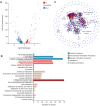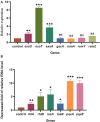Novel Insight of Transcription Factor PtrA on Pathogenicity and Carbapenems Resistance in Pseudomonas aeruginosa
- PMID: 35959145
- PMCID: PMC9359796
- DOI: 10.2147/IDR.S371597
Novel Insight of Transcription Factor PtrA on Pathogenicity and Carbapenems Resistance in Pseudomonas aeruginosa
Abstract
Introduction: Globally, Pseudomonas aeruginosa (PA) is emerging as a predominant nosocomial pathogen that often induces aggressive and even deadly infections. Pseudomonas type III repressor A (PtrA) can be activated specifically by copper ions and interacts with type-III transcriptional activator ExsA. This study aims to provide insight into the PtrA-mediated regulation of the pathogenicity and antibiotics resistance of PA.
Methods and results: The results of transcriptome sequencing analyses and real-time fluorescence quantitative polymerase chain reaction (RT-qPCR) showed that PtrA plays a dual regulatory role in the virulence systems of PA: negatively regulates the type-III secretion system (T3SS) and positively regulates the quorum-sensing system (QS). The ptrA mutant attenuated extracellular virulence related to QS like pyocyanin, elastase, rhamnolipids, proteolytic activity, and biofilm production. According to adhesion and invasion experiments, PtrA can not only contribute to the adhesiveness but also the invasive of PA. Moreover, the PtrA-mediated regulation of PA pathogenicity was determined both in vivo and in vitro through cytotoxicity and Galleria mellonella survival experiments. In addition, apart from virulence, PtrA was found to influence the carbapenems resistance of PA. After deleting ptrA, the minimum inhibitory concentration (MIC) of carbapenems antibiotics was decreased by 2-fold, while a 2-8 fold increase was noted for the complemented strain.
Conclusion: Our findings establish that PtrA exerts a regulatory role in both pathogenicity and carbapenems resistance of PA. This work may shed light on a novel target for the clinical treatment of PA.
Keywords: Pseudomonas aeruginosa; PtrA; Quorum-sensing; T3SS; carbapenems resistance; pathogenicity.
© 2022 Zhang et al.
Conflict of interest statement
The authors report no conflicts of interest in this work.
Figures







Similar articles
-
The Small RNA AmiL Regulates Quorum Sensing-Mediated Virulence in Pseudomonas aeruginosa PAO1.Microbiol Spectr. 2022 Apr 27;10(2):e0221121. doi: 10.1128/spectrum.02211-21. Epub 2022 Mar 9. Microbiol Spectr. 2022. PMID: 35262393 Free PMC article.
-
Baicalin inhibits biofilm formation, attenuates the quorum sensing-controlled virulence and enhances Pseudomonas aeruginosa clearance in a mouse peritoneal implant infection model.PLoS One. 2017 Apr 28;12(4):e0176883. doi: 10.1371/journal.pone.0176883. eCollection 2017. PLoS One. 2017. PMID: 28453568 Free PMC article.
-
An in vivo inducible gene of Pseudomonas aeruginosa encodes an anti-ExsA to suppress the type III secretion system.Mol Microbiol. 2004 Oct;54(2):307-20. doi: 10.1111/j.1365-2958.2004.04282.x. Mol Microbiol. 2004. PMID: 15469505
-
Sesamin and sesamolin rescues Caenorhabditis elegans from Pseudomonas aeruginosa infection through the attenuation of quorum sensing regulated virulence factors.Microb Pathog. 2021 Jun;155:104912. doi: 10.1016/j.micpath.2021.104912. Epub 2021 Apr 28. Microb Pathog. 2021. PMID: 33932548 Review.
-
Non-antibiotic methods against Pseudomonas aeruginosa include QS inhibitors: a narrative review.Ann Palliat Med. 2021 Jun;10(6):6926-6935. doi: 10.21037/apm-20-2247. Epub 2021 May 20. Ann Palliat Med. 2021. PMID: 34044573 Review.
Cited by
-
Identification of a novel transcriptional regulator, CorR, for copper stress response in Edwardsiella piscicida.Appl Environ Microbiol. 2023 Oct 31;89(10):e0089923. doi: 10.1128/aem.00899-23. Epub 2023 Sep 21. Appl Environ Microbiol. 2023. PMID: 37732742 Free PMC article.
-
Quorum sensing gene lasR promotes phage vB_Pae_PLY infection in Pseudomonas aeruginosa.BMC Microbiol. 2024 Jun 10;24(1):207. doi: 10.1186/s12866-024-03349-7. BMC Microbiol. 2024. PMID: 38858621 Free PMC article.
-
Evaluation of the antibacterial, antibiofilm, and anti-virulence effects of acetic acid and the related mechanisms on colistin-resistant Pseudomonas aeruginosa.BMC Microbiol. 2022 Dec 19;22(1):306. doi: 10.1186/s12866-022-02716-6. BMC Microbiol. 2022. PMID: 36529724 Free PMC article.
References
-
- Beasley KL, Cristy SA, Elmassry MM, Dzvova N, Colmer-Hamood JA, Hamood AN. During bacteremia, Pseudomonas aeruginosa PAO1 adapts by altering the expression of numerous virulence genes including those involved in quorum sensing. PLoS One. 2020;15(10):e0240351. doi:10.1371/journal.pone.0240351 - DOI - PMC - PubMed
LinkOut - more resources
Full Text Sources

